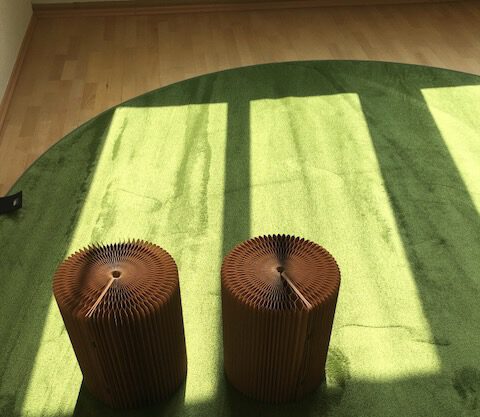Childcare models for the child after the parents have separated
Advantages and disadvantages of the residential model, the alternating model and the nest model
Introduction
When parents separate or divorce, it is not only the perspective as a couple that needs to be reorganised, both parents also have to re-sort their parental responsibilities. And since this particularly affects the child or children, who are also entitled to protection and care, this matter is ultimately not just a matter for the parents. Mediators in separation and divorce mediation are therefore well advised to explicitly focus on the concerns of the child, who is probably not present in the mediation.
Sooner rather than later, the question of how the child's care can be adequately guaranteed and sustainably reorganised will therefore arise as to the new form of care. Parents basically have a choice of three different childcare models, which can of course be customised.
- There is the Residence modelwhere the child lives primarily with one parent (who is entitled to care) and visits one parent (who is entitled to contact and has a maintenance obligation) from time to time.
- There is also the Alternating model, where the child is cared for by both parents on a largely 50/50 basis. The child then changes its place of residence on a weekly, fortnightly or monthly basis and thus its centre of life
- And there is the Nest modelwhere the child stays in the flat and the parents take turns looking after the child there, but otherwise start to reorganise their new life in other flats. In this case, three flats are needed.
As mediators, we know how important it is to find a suitable care arrangement for the children after a separation. This is often the primary and generally the most important issue in divorce and separation mediation. The legal mandate and also the focus of mediation is to place the child's welfare at the centre, while at the same time taking into account the needs of the parents and allowing them to develop.
In the following article, I will briefly introduce the three basic care models - the residential model, the alternating model and the nest model - and name their advantages and disadvantages. When working in mediation, it is more than helpful to know the basics in order to be able to plan your interventions and mediation discussions well in general.
Residence model
Description: In the residential model, the child lives mainly with one parent, while the other parent has regular visiting hours, to which he or she is entitled but also obliged. Visiting hours means that the child is allowed to stay with this parent on a visitation basis, not that the parent is allowed to visit the residence. To a certain extent, this is the traditional model that is often chosen because even before the separation, one parent had the main responsibility for caring for the child. In a sense, the usual division of labour is now continued with the parents living in different places.
Advantages of the residence model:
- Stability: Despite all the changes for the child that go hand in hand with the separation, the place of residence remains the same for the child. This is particularly important for younger children, especially as day-care centres and schools would also become an issue along with the place of residence. The residence model guarantees stability for these social contact points for the child.
- Clear structures: Fixed visiting times mean that everyone involved knows when the child is with which parent.
- School and leisure activities: Participation in school and extracurricular activities, contact with friends, acquaintances and relatives is easier to plan if the residence is not only maintained for the child, but is also de facto made possible by the increased care provided by a parent.
- Less contact between parents at odds with each other: If communication between the parents is difficult, this model offers less cause for conflict.
Disadvantages of the residence model:
- A feeling of being torn apart: The child may feel torn between the parents.
- Alienation/weaker bond: The continuity in the relationship with the non-carer parent has to be put on a new footing and is sometimes experienced as weaker. Of course, there are also parents who find a new division of labour as a result of the separation – and achieve a tangible division at all. Sometimes it is only the separation of the parents that enables and forces one parent to commit to caring for a fixed period of time and to do so (alone). This may not be much (a short weekend every fortnight), but it is sometimes a period of time that can be experienced.
- Imbalances in the assumption of responsibility, experience of responsibility, emotions of responsibility: The residential model demands more from the primary carer. This parent bears the main responsibility and is more burdened with everyday problems (health issues, childcare issues, daycare or school problems, etc.). In a mirror image, the other parent sometimes feels excluded, cut off, ineffective, but sometimes also more financially burdened. This imbalance often leads to tensions between the parents.
- Ties or limited flexibility: The caring parent can be less flexible in terms of professional and personal commitments. This parent has a child to look after at home, while the other parent lives the majority of their life alone and is free and unbound in this respect. The visiting time itself is then often experienced as a welcome, eventful, exciting time together with the child, which is not at all restrictive, but rather enriching („Weekend Daddy“). This sometimes leads to feelings of envy and a sense of injustice in the other parent.
Alternating model
In the alternating model, the parents share the care of the child more or less equally. The child alternates between the parents' households, e.g. weekly or monthly. The basic idea is that the child receives roughly equal contact and care time with both parents and that both parents also experience each other as carers. In this case, it is no longer possible to speak of visiting times in the traditional sense, but the child is fully present at one of the two places of residence. Despite the stability of the carers, the child is expected to undergo considerable changes in terms of place of residence and personal logistics.
Advantages Alternating model:
- Allocation of roles and tasks: Both parents remain active in the child's life and share the responsibility of parental care requirements. The division of labour model is divided (more) fairly from the respective individual perspectives. While the division of labour was often only carried out from the couple's perspective (motto: whoever can earn more often takes on this part more, so that the traditional role model could live on in society…), the logic of the individuals comes to the fore again after the separation.
- Stable, but above all fairly divided relationship spaces: The child has continuous contact with both parents with the same intensity in terms of time.
- Two homes: The child can, but must also feel at home in both households.
- Fair distribution: The financial and caring burden is distributed more fairly.
- Diverse experiences: The child has the opportunity to gain different experiences and perspectives from both parents, especially when both parents enter into new partnerships.
Disadvantages Alternating model:
- Sophisticated design: Effective, intensive and honest communication between the parents is necessary. A great deal of logistical effort is also required (handovers!).
- Proximity to places of residence: The places of residence should be close to each other, also so as not to interfere with the child's school and leisure activities. In general, the alternating model only seems possible if both parents live in the same city.
- Load due to change: The regular changes are exciting, sometimes stressful, especially for the child. Constant changes in social norms and relationship cultures, especially when complete patchwork families emerge in the course of developments, i.e. new life partners of the parents, possibly with additional siblings.
- Different rules and social norms: It can be difficult to maintain consistent parenting styles and rules in both households. The agreements and information involved can also be overwhelming for parents.
- Logistical challenges: The constant change can cause logistical difficulties in terms of transport and scheduling. Where are which toys, what always has to move with the child (cuddly toys, play equipment, etc.)?
Nest model
In the nest model, the child remains in the familiar environment while the parents take turns caring for the child in the nest, but otherwise begin to build and settle into their new lives in their own new homes. This means that the parents each need their own home for the time when they are not caring for the child.
Advantages of the nest model:
- Stability for the child: The child does not have to move and retains its usual centre of life as well as the contact area with both parents.
- Familiar surroundings: The child lives in a place that is not new, practically retains its familiar surroundings and does not have to constantly readjust. There is no stress for the child due to the constant change of residence. From the point of view of fairness, this seems desirable: if only the parents' couple relationship breaks down, but not the parental relationship, then the parents should also accept the uncertainties of moving house. But this is merely a normative idea that is hardly practicable.
- Good bond with both parents: Due to the regular changes, a close relationship with both parents remains in principle.
- Focus on the child: Parents can take turns to concentrate fully on their child without the distraction of other commitments.
Disadvantages of the nest model:
- Resource-intensive: As a rule, three homes have to be financed. In addition, two people, the parents, each have two places of residence instead of just the child. Not only family resources play a role here, but also community resources: „Is there even the appropriate housing supply?
- Little privacy: Sharing a property can affect the privacy of the parents.
- Good communication required: Smooth communication between parents is essential.
- Organisational effort: The regular change of parents in the shared household requires good organisation and coordination.
- Emotional stress: Parents regularly have to say goodbye to each other and leave home together, which can be emotionally stressful. This is all the more true if the child's nest was once the couple's nest, which is often the case.
Conclusion
As mediators, it is also our job to help families find the most suitable childcare model for them. And none of the care models will optimally fulfil every detail of the requirements. This is due to the already difficult situation.
Each model has its own advantages and disadvantages, which we can make transparent to the parents in mediation without having to act as a family or specialist counsellor. It is important that the child's welfare is prioritised, especially as the person is usually not present. Through our support in separation and divorce mediation, we can help to restore stability after a separation and create a new family structure.








Leave A Comment